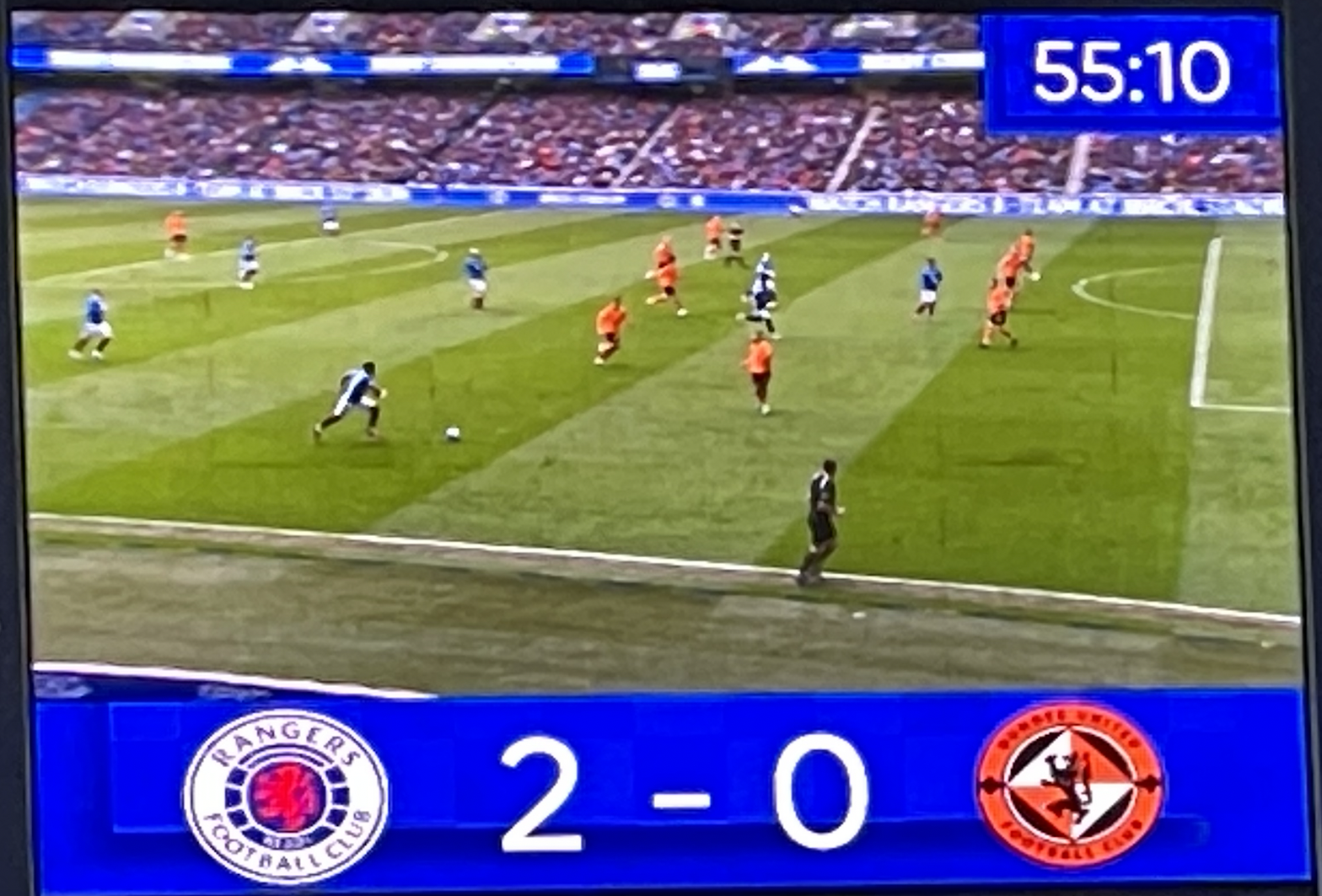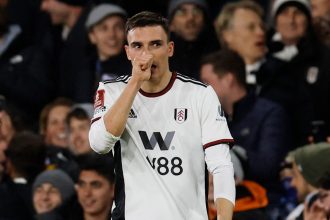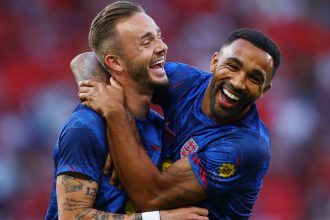By David Herd
This weekend, Rangers fans get the rare treat of attending Ibrox at the traditional 3pm on a Saturday. The opposition is Dundee United, a team whose fans in recent times have developed a deep hatred of our club, and who sit just a place behind Rangers in the table after a very decent start to their first season back in the top flight.
Younger fans will doubt we have ever shared much with these visitors, after all they started out as Dundee Hibernian in 1909 and look to have far more in common with the team on the other side of Glasgow. But over the years, there have been many men who have represented both clubs on and off the pitch. By far the most famous has to be the great Walter Smith, the greatest Rangers manager of the last half century, and a manager who belongs in the debate on the ultimate legends of Ibrox. He wore the United colours well over 150 times across two spells as a player, and was assistant manager at Tannadice in their glory years in the early 1980s before moving to his spiritual home in 1986 to assist new boss Graeme Souness.
Most Read on FollowFollow.com Dessers Departs – A look back at Cyriel The FollowFollow.com Friday Preview – Hearts at Home Rangers Quotes from Brugge
He is by no means the only manager who has links to both clubs, as United’s greatest-ever manager Jim McLean was the brother of the Rangers right winger in the 1972 ECWC triumph in Barcelona, the wonderfully skilful Tommy McLean. He would go on to manage United too for a spell in the 1990s. The very first former Rangers player to take the reins at Tannadice was well before this, however, when Willie Reid was appointed in June 1931. His is name few modern supporters will recognise, but Reid was one of the greatest goalscorers in the 152-year history of Rangers, a man whose incredible scoring record still sees him in the official top 10 of all-time in a royal blue shirt. These records discount minor competitions such as the Glasgow Cup, and also exclude the competitions played during World War Two. His seventh place is despite there being no League Cup or European football back in his days as the Rangers centre forward between 1909 and 1920, and when only league goals are counted he jumps up to fourth with only McCoist, McPhail and Smith in front of him.
Reid never played for United, but looking through the history books, there have been several outstanding centre forwards who did score goals for both clubs. And the main discussion point of this article is to debate just who is the best “number nine” to have led the line for Rangers and for this Saturday’s opponents. Reading the shortlisted names probably will make a few weep when comparing them to who we watch at the moment. Where would we be right now if any of these five players was currently wearing the Number Nine for Rangers?
OPTION ONE – GEORDIE HENDERSON
Fair to say, this will be the least expected name in the list, and by far the least known. Geordie Henderson joined Rangers in 1919 as one of the last signings made by the club’s first manager William Wilton, and the Dundee-born striker went on to become the first of many great goalscorers for his successor William Struth. He is not as revered as those who followed him as the leader of the Ibrox attack, but Henderson’s strike rate and importance to title-winning teams was as impressive.
After starting Struth’s first season in charge in the reserves, Henderson was first selected by the manager in a league game when he started against Dundee at Ibrox in November 1920. He scored four times. He then scored four more in his second start. By the time the season ended, Struth had won his first of 18 official league titles, and Henderson had blasted 21 goals in 23 games to claim his first league medal.
He was the first choice Rangers centre forward until the autumn of 1925, when an injury forced him onto the sidelines for several weeks. By then, he had been the main goalscorer in four league title wins, with a narrow second-place finish behind Celtic in season 1921/22 the only time he had failed to claim the championship. Over those five seasons, he scored 130 goals in 164 starts in league and Scottish Cup, as well as plenty vital counters in the important “minor” competitions of the time, The Glasgow and Charity Cups. Despite this impressive haul, he would then lose his place as Struth’s preferred centre forward to Jimmy Fleming, a signing from St Johnstone who went on to become the next goals machine of the Struth era.
Henderson remained at the club until early 1927, when he left for English club Darlington for the sizeable sum of £2,250. In all competitive matches, he had scored 161 times in 222 games, a strike ratio of around 73% that compares with most of the great scorers of Rangers history. Geordie Henderson would leave Darlington and play for a time in North America for the New York Nationals. He scored twice in the final of the National Challenge Cup in 1928, when the New York team lifted the trophy. But he would return to Scotland to join Dundee United of the Second Division that summer. Now something of a veteran, and often utilised more as an inside forward than leading the line, Henderson still managed to give the Tannadice fans some happy times. He scored the winner in a Dundee derby in the Scottish Cup, and was a huge influence in them winning promotion back to the top division. Once there, he would score against both halves of the Old Firm, with a goal at Ibrox in a 3-1 defeat plus both goals in a 2-2 draw with Celtic at Tannadice. Despite this, United were relegated and Henderson left after just two seasons. His 13 goals in 36 league appearances for them in 1929/30 was a more than decent return when playing in a team struggling to compete.
After retiring from football, Geordie Henderson became a publican in Dundee, before his death in 1953 at the age of 56. He was only the first choice Rangers centre forward for five seasons, but overall he scored more goals for the club than Mark Hateley, Colin Stein, Derek Parlane or Kris Boyd. He deserves to be remembered.
OPTION TWO – JIMMY MILLAR
Millar was celebrated recently in a film by the official Rangers TV channel, it being released in the week that would have seen his 90th birthday. His is a name still revered by many, and a look at his magnificent Rangers career soon shows why. He was signed as a half back from Dunfermline in 1956, but his conversion to centre forward in 1959 after a goalscoring spree in pre-season in Denmark changed his career.
A fully committed player who lived for the cause, Millar became the automatic choice at number nine, and was a huge reason for the dominance that Rangers enjoyed in the early 1960s. Excellent in the air despite not being the tallest of players, he was both a brilliant leader of the line who could hold up the play, and a deadly goalscorer. And, like all the greatest Rangers strikers, he scored important goals in the biggest occasions. He scored EIGHT goals against Celtic in the calendar year of 1960, including three in the Scottish Cup semi-final matches against them. He scored THIRTEEN times against Celtic in his Rangers career, hitting their net in three New Year victories over them. He scored doubles in the 1960 and 1964 Scottish Cup final wins, as well as scoring in two League Cup final matches. Millar played in no fewer than NINE major domestic cup finals at Hampden for Rangers, and he never lost any of them.
The famous forward line of Millar, Brand and Wilson delivered the goals that brought trophy after trophy to Ibrox under manager Scot Symon. Millar would hit 40 competitive goals in a season twice, in 1959/60 and 1962/63, and he would return to a more defensive role later in his career when the prolific young Jim Forrest grabbed the number nine shirt. Despite only playing as the main centre forward for around two-thirds of his competitive starts for the club, his 170 goals sees him sit fifth in the list of post-WW2 scorers.
In 1967, Millar was sold to Dundee United, where he teamed up with his brother Tommy and also continued his on-field partnership with Davie Wilson. Now a half back of great strength and desire, Millar’s time at Tannadice was badly hampered by injuries. Despite his total devotion to Rangers, he would come back to haunt the team he loved in the run-in to the title in early April 1968, when he played his part in securing a 0-0 draw against Davie White’s team as the league championship race between the Old Firm was on a knife edge. That dropped point would prove crucial come the end of the campaign. He would play 22 times for United, before a brief spell in management with Raith Rovers.
Jimmy Millar would remain an idol to many, with men such as Sir Alex Ferguson and Walter Smith naming him as their all-time favourite Rangers player. He was a regular alongside old strike partner Ralph Brand in the hospitality suites inside Ibrox for many years until illness prevented him attending the stadium, He passed away at the age of 87 in 2022 after a long battle with dementia.
OPTION THREE – DEREK JOHNSTONE
A boyhood United fan from the city of Dundee, Johnstone was a prodigious schoolboy talent on the football field, and he signed as a schoolboy for Rangers in 1968. “DJ” would go on to set all kinds of records as a Rangers player, in a career that saw him wear the royal blue well over 500 times.
At the age of 16 years and 319 days, he made his debut against Cowdenbeath in the league in September 1970. He scored twice, thus becoming the youngest league debutant ever to score for the club. A few weeks later, he headed home the only goal of the League Cup final against a Celtic team that had reached a European Cup final earlier that year. An instant hero to a whole generation of Rangers fans starved of success, Johnstone became the youngest ever scorer in a major cup final in the UK. By the end of that debut season, he had also scored against Celtic in the Scottish Cup final at the age of 17, the first ever substitute to score in the national showpiece match.
Despite his goals, the number nine shirt was firmly in the possession of Scotland’s centre forward Colin Stein, so Johnstone showed incredible football adaptability by then converting into a defender. He starred in midfield at the age of 18 as Rangers reached the 1972 European Cup-Winners’ Cup Final, then moved back to centre half for the final in the absence of the injured Colin Jackson when he became the youngest Scot ever to win a European trophy. By 19, he had been capped by Scotland at the back, and had won his first Scottish Cup in an epic win over Celtic.
Derek Parlane was now the regular number nine, with Johnstone playing at the back, in the middle of the park, and also sometimes up front. In season 1974/75 he hit 14 league goals despite rarely leading the line, as Jock Wallace’s men finally reclaimed the title after eleven agonising years. Johnstone was named in the team of the year in midfield, and also won a Scotland cap as a midfielder, but the following season saw him make the move back up front with devastating consequences for the opposition. He hit 31 goals as Rangers swept to the treble, including a double in the Scottish Cup semi-final and in the final against Hearts.
Regarded by many as the best in the air they have seen play for the club, Johnstone was the perfect target for the pinpoint crosses of winger Tommy McLean. But he scored every type of goal, typified that season by the magnificent 20-yard volley against Celtic at Ibrox on the opening day. Like any truly great Rangers striker, he enjoyed plenty of goals against the club’s biggest rivals, his eleven Old Firm strikes coming in matches at Ibrox, Parkhead and Hampden. And he became the first player ever to finish top scorer in two treble-winning seasons in 1978, his 39 goals in 1977/78 ensuring he made more history by winning both of the Scottish Player of the Year awards in the same season. To this day, few can explain the decision of Scotland manager Ally McLeod not to utilise DJ in the World Cup finals in Argentina after his devastating scoring form, which had included the winner in the Scottish Cup final then the only two goals scored by Scotland in the Home Internationals.
The departure of Jock Wallace and the appointment of skipper John Greig as manager saw Johnstone named club captain for season 1978/79, but although he scored two more Scottish Cup final goals in the win over Hibs and also lifted the League Cup, his preference of playing at centre half and the devastating defeat in the title decider at Parkhead meant that Greig’s reign suffered a blow from which it never really recovered. But despite the team never again truly challenging for the title under the legendary captain, Johnstone still enjoyed more success in both cups and scored goals in big domestic and European matches.
He left Rangers in 1983 for Chelsea, no longer the player he had been at his peak, yet still only 29 years old. A return in January 1985 under old boss Wallace was unsuccessful, Johnstone now a veteran centre half who struggled against players he would have swatted aside back in his pomp. But despite the lack of success in later years, and despite his frequent appearances as a defender, DJ still managed 210 goals in major competitions, which made him the top scorer for the club since WW2. Incredibly, there wasn’t a single penalty kick in that total. Only Ally McCoist has since scored more Rangers goals.
Including friendlies, Derek Johnstone played over 600 games for Rangers. What is less remembered is his six matches for Dundee United. He joined Jim McLean’s league title holders on loan for a month from Chelsea in late October 1983, scoring twice against Morton on his debut for the Tangerines. But with injured players returning, McLean dropped him to the bench after just two more starts, with the last of his three substitute appearances coming at Ibrox against a Rangers team welcoming Jock Wallace back into the dugout for his first home game since returning as manager. The match ended 0-0, probably the ideal result for the player.
Derek Johnstone enjoyed a long career in the media after leaving football, and is still hugely popular at the fan events he attends.
OPTION FOUR – ANDY GRAY
The question being posed here is who is the best centre forward to have played for both Rangers and Dundee United. The next contender enjoyed spells at both clubs, and therefore qualifies. Like the final player in the list that is still to come, it is accurate to say that Andy Gray’s most successful times were while playing at neither club.
Glasgow born, and brought up a staunch Rangers fan, the teenage Gray signed for Dundee United in 1973 from the quaintly named Clydebank Strollers. The young striker was fearless and committed on the pitch, and was quickly given his debut by Jim McLean in a League Cup tie against Motherwell when still just 17. By the age of 18 he was the club’s first choice to lead the line, memorably scoring four goals in a match just after his 18th birthday against Dumbarton, and scoring important goals in United’s run in the Scottish Cup that took them all the way to the final. Gray would leave the Hampden pitch disappointed after losing to Celtic, but his Tannadice career continued in impressive style the following season when he finished 1974/75 as the joint-highest scorer in the top division.
By September 1975, he was a Scotland under-23 internationalist, and his goals had been noticed by several English clubs. After 47 goals in 95 United appearances, he moved to Aston Villa for £110,000. In Birmingham, he quickly became a genuine star. He won the first of his 20 Scotland caps three months later, and in 1976/77 he jointly won the Golden Boot as top scorer in the English top flight with 29 goals. He also helped Villa to the League Cup when they defeated Everton in a second replay, starting the two drawn games before missing the decisive match through injury. He was named the English Player of the Year and Young Player of the Year at the end of the season, at the time the youngest player to have won the main award.
In 1979, he moved to Wolves for a British record transfer fee of £1.49million, and he got his hands on that League Cup medal the following year when he scored the only goal in the Wembley final against Brian Clough’s Nottingham Forest, who were the European champions. At Wolves, he suffered a relegation and won promotion, before he left the Midlands for Merseyside in November 1983. He would go on to enjoy his greatest successes in the blue of Everton. A massive fans’ favourite up front alongside fellow Scot Graeme Sharp, Gray was the spearhead of Howard Kendall’s team that won three major honours. Gray scored the second goal in the 1984 FA Cup final win over Watford, then completed his set of the major English trophies when The Toffees raced to a first league title since 1970, dethroning arch-rivals Liverpool. Gray then set the seal on probably his greatest season when scoring the opener in Everton’s 3-1 win over Rapid Vienna in the 1985 European Cup-Winners’ Cup final in Rotterdam.
Due to the horrific events involving Liverpool fans at the European Cup final that May, Everton did not get the chance to compete in the European Cup the following season as English clubs were banned from UEFA competition. This would be without Gray anyway, as the club bought Gary Lineker in a big-money move in the summer and decided to sell the now veteran Gray to old club Aston Villa, despite a fan petition at Goodison demanding their hero stay at the club. His time at Villa second time around was less impressive than the first, and a move to second-tier West Brom seemed to signal the end of the big time for Gray. But there was one last major transfer for him in September 1988, the move that he had always hoped would come.
Just before Gray’s 33rd birthday, Graeme Souness paid £25,000 to bring him to Ibrox during an injury crisis that saw both Ally McCoist and Kevin Drinkell sidelined. His debut came as a substitute in a League Cup semi-final win over Hearts at Hampden, and it was mainly from the bench that the Rangers fans saw Andy Gray. Only three of his 16 Rangers appearances were from the start, making his five goals all the more impressive. In the successful league campaign, the first of the legendary nine-in-a-row, Gray earned his medal with a vital late equaliser at Love Street, as well as strikes against Hearts, Hamilton and a winning double in a 2-1 win over Dundee. He got to live his dream by playing in the Old Firm match, and although not used in the winning League Cup final nor the losing Scottish Cup final, he left Ibrox after just that one season with the appreciation of all in the dressing room and in the stands.
Andy Gray briefly played non-league football with Cheltenham Town before retiring from the game in 1990. He has gone on to enjoy a long career in the media as a football pundit, most memorably for many years with Sky Sports before moving to a channel in the Middle East. He has never hidden his love of Rangers, and has occasionally been seen at fan events and inside the stadium. He may not have been a great Rangers centre forward, but he was an excellent player at the highest level.
OPTION FIVE – DUNCAN FERGUSON
Like Andy Gray, the story of Duncan Ferguson’s senior career starts at Tannadice. The Stirling-born youngster signed for United as a schoolboy, and was just 17 when making his competitive debut as a substitute in a 2-1 win over champions Rangers at Ibrox in November 1990. Before long, he was the hottest young prospect in the country, still a teenager when in the losing 1991 Scottish Cup final against Motherwell and a regular in the Under-21 team for his country. He was United’s top scorer the following season, making his full international debut at the end of the campaign against USA in May 1992 at the age of 20. He had scored twice against both Rangers and Celtic that season, and a winning goal at Parkhead on Boxing Day that year saw the newspapers predict a big money move south was a matter of time. Those headlines grew more frequent after an international appearance against World champions Germany at Ibrox in 1993, when his spectacular acrobatic volley almost rescued a draw.
By the end of season 1992/93, his departure from Tannadice looked inevitable after 35 goals in 88 United appearances. But his transfer became something of a saga when treble-winners Rangers made their intentions clear with a huge offer for the player, and the player making it clear that Ibrox was where he saw his future. The problem was United boss Jim McLean, who was determined not to sell his star asset to a domestic competitor, preferring to court bids from south of the border. There was then a battle of wills between the two sides, Rangers upping their offers, McLean refusing to buckle, and multi-million bids from English teams ignored by Ferguson himself. Eventually, Rangers won the battle, with chairman David Murray seemingly more determined not to lose face than McLean.
Just days after Manchester United smashed the British transfer record to sign Irish midfielder Roy Keane from Nottingham Forest for £3.75million, Murray sanctioned a bid of £4million for Ferguson, one that McLean and United simply could not refuse. Duncan Ferguson became a Rangers player on July 15th 1993.
But despite the massive expectations from the support, his Rangers career never really took off. He was carrying an injury when he signed, and missed the opening matches of the new season, which Mark Hateley started in magnificent form while the fans awaited the return of Ally McCoist from his leg break. Ferguson’s debut came at Parkhead, and he played well in a tight 0-0 draw. But more injury problems would follow, restricting the record transfer man to just seven league appearances. His first goal came in a 4-0 Ibrox romp against Raith Rovers, but that win marked the day that Ferguson’s club career in Scotland began to end. He was involved in an altercation with defender Jock McStay, appearing to headbutt the Rovers man. Although neither club, nor McStay himself, made any fuss over the incident, the police used the TV pictures to charge the player with assault. A guilty verdict was delivered in court in early 1995, and with Ferguson already in trouble with the law after previous off-field incidents while at United, he was sentenced to three months in prison. Meanwhile, the SFA decided to further punish the player on hearing of the police decision to prosecute, hammering him with a 12-game ban.
On the pitch, Ferguson had endured a defeat in the 1994 Scottish Cup final, and despite starting season 1994/95 with a winner against Motherwell and a hat-trick in a League Cup match at Arbroath, he was unable to displace Hateley as the Ibrox attacking figurehead. Struggling for game time and resentful at his treatment by the authorities north of the border, he accepted the chance of a loan move to Everton in October 1994, initially along with Ian Durrant. The midfielder returned to Ibrox after a month, but Ferguson was determined to stay in English football, and his move became permanent in November for a fee of £4.4million. Everton were in relegation trouble and desperate for a hero, and in Ferguson they found the man they were looking for. He was strong, great in the air, loved a physical battle, and also scored goals. His place in Everton hearts was sealed when scoring a towering header to open the scoring in his first Merseyside Derby to open his goals account for his new employers, as Everton beat Liverpool 2-0 live on Sky television. It was new manager Joe Royle’s first game in charge.
Ferguson was a massive part of Everton avoiding the drop, and the season also had a silver lining. Everton reached the FA Cup final where they faced holders and hot favourites Manchester United. Ferguson was named on the bench after recent injury, and his replacement at centre forward Paul Rideout (another former Rangers player) scored the only goal at Wembley after half an hour. Ferguson more than played his part in the triumph, replacing Rideout after 50 minutes. The team failed to build on this triumph, however, and by the summer of 1998 Royle was gone and Walter Smith was in charge at Goodison. He inherited a team that were struggling, but whose fans still worshipped Ferguson, who had made Premier League history the previous season by becoming the first player to score a hat-trick of headers in a match in a 3-2 win over Bolton.
Smith saw Ferguson as the man he would build his attack around, but he was left angry and disappointed just months into his reign when the club sold their talisman behind the manager’s back during a time of financial crisis. The £8million bid from Newcastle United was too much to refuse for the board, but Ferguson’s departure left a serious trust issue between the Goodison boardroom and manager’s office. After 133 Everton appearances and 42 goals, Ferguson was heading to Tyneside to play for manager Ruud Gullit. He looked to be a bargain buy for the Dutchman when hitting a double on his debut against Wimbledon.
At this time, the player was hampered by persistent injury issues, particularly a hernia problem. But when fit, Ferguson became a powerful and effective strike partner for the brilliant Alan Shearer, with their goals helping the team to the FA Cup final. The match was lost, to the history-making treble side of Manchester United. His most consistent spell in the team when injury free was in early 2000, and he showed what might have been with six goals in six matches including strikes against Liverpool, Spurs, and a fine double against Southampton. But his injury curse struck again after starting in the losing FA Cup semi-final to Chelsea, and his record on Tyneside ended with 12 goals in 41 appearances. He was sold back to Everton for less than half the fee Newcastle had paid, making a triumphant return in August 2000 to the club he had never really wanted to leave.
Despite scoring a double on his second home debut, Ferguson’s return was not a huge success, mainly due to his persistent injury issues. When fit, he remained a fearsome presence who could terrorise the best defences, but he was only able to start less than half of Everton’s matches in his last five seasons at the club before deciding to retire in the summer of 2006. Injuries, as well as an increasingly poor disciplinary record had reduced the 34-year-old to the role of substitute for manager David Moyes, so after 272 Everton appearances and 72 goals, his career was over.
Regarded by many as one of the finest centre forwards of the first decade of the English Premier League on his day, Ferguson only had that one FA Cup winner’s medal to show for his efforts, with many pundits agreeing that injury had robbed him of far more impressive career statistics. This included just seven Scotland caps, the player refusing to play for his country again after 1997 in the aftermath of his bitter fall-out with the Scottish football authorities.
He remained a hero at Goodison, and played his part in the backroom team of several managers as well as two short stints as caretaker boss. His brief spells in charge included a memorable win over Chelsea in front of a raucous home crowd, and a hard-earned draw at Old Trafford. Ferguson was also awarded a testimonial by the club in 2015. His most recent managerial job was in Inverness, when financial implosion made his job almost impossible before he was dismissed after the club was placed in administration.
Ferguson would not be in consideration by fans of either Dundee United or Rangers as their best number nine, but at his peak he has a claim to be as good a Scottish centre forward as any of the last 25 years.
So, there we have the five nominees for the best centre forward to have played for the two clubs facing each other this weekend at Ibrox. There have been many others who represented both teams, but nobody would surely select Davie Dodds, Iain Ferguson, Gary McSwegan, Steven Thompson, Billy Dodds, Fran Sandaza or Jon Daly ahead of any of those five. There was one man who has the record as the only Rangers centre forward in the last 80 years to score six goals in a match, and he also played for Dundee United. But Davie Wilson was a winger, his incredible six-goal haul against Falkirk in 1962 in a 7-1 win was a rare day he played through the middle when Jimmy Millar was out injured.
At a time when the Rangers forward line has a regularly misfiring number nine, a regularly injured alternative, and an inexperienced rookie as the only other option, seeing these five names can only make us yearn for better than what we have. The question for those who have read this article to the end is… which one of the five would you pick if we could bring him back again in 2024?








